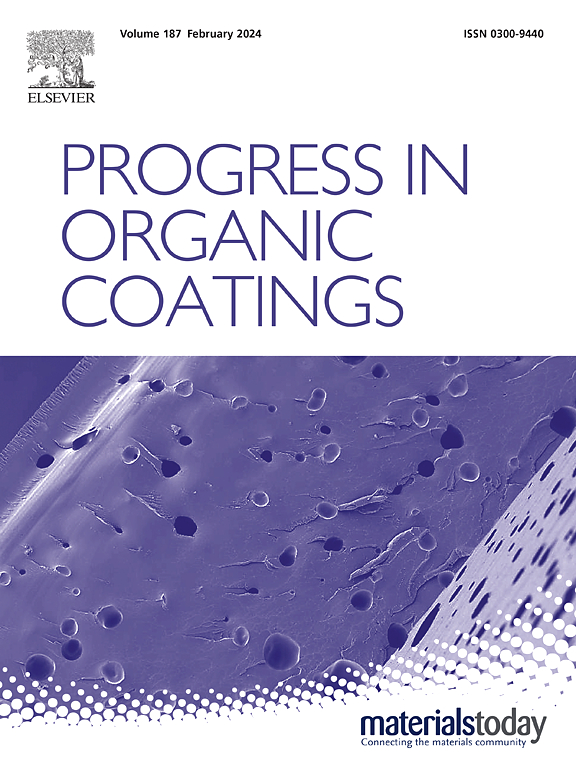具有强大抗腐蚀和抗菌性能的超疏水铈掺杂卡丹醇聚脲纳米复合涂层的合成与表征
IF 6.5
2区 材料科学
Q1 CHEMISTRY, APPLIED
引用次数: 0
摘要
本文章由计算机程序翻译,如有差异,请以英文原文为准。

Synthesis and characterization of superhydrophobic ceria doped cardanol polyurea nanocomposite coatings with robust anti-corrosive and antibacterial properties
This study reports the synthesis and characterization of superhydrophobic ceria (1–5 %) -doped cardanol polyurea nanocomposite (CP@CeO2) coatings with exceptional anti-corrosive and antibacterial properties. The coatings were fabricated by incorporating ceria nanoparticles into a cardanol-based polyurea matrix, resulting in a unique nanomaterial with improved thermal stability, mechanical resistance, and hydrophobicity. Fourier-transform infrared spectroscopy (FTIR) confirmed the successful formation of the nanomaterials. Field emission scanning electron microscopy (FE-SEM) and high-resolution transmission electron microscopy (HR-TEM) analyses revealed a uniform distribution of ceria nanoparticles (12 nm to 20 nm) within the polyurea matrix. Atomic force microscope (AFM) shows an approximate roughness of 63.96 nm from the observed root mean square (RMS) value, Skewness value, and Kurtosis value. The coating's contact angle value of 150–155° demonstrates a superhydrophobic surface due to the synergetic nanoparticles distribution, surface composition, and roughness. The coatings exhibited remarkable mechanical properties, including excellent crosshatch adhesion (100 %), bending resistance (passes 1/8 in.), scratch hardness (3.2 kg), pencil hardness (6H), and impact resistance (150 lb./in.). The anti-corrosive stability of the coating was evaluated using electrochemical impedance spectroscopy (EIS), which showed a long-lasting efficiency of 96 % over 18 days. Furthermore, the coatings displayed antimicrobial properties against Gram-positive bacteria, Bacillus subtilis, making them suitable for various industrial applications requiring corrosion protection and antimicrobial resistance.
This work highlights the potential of ceria-doped cardanol polyurea nanocomposite coatings as a novel material for diverse applications where both corrosion protection and antimicrobial properties are essential.
求助全文
通过发布文献求助,成功后即可免费获取论文全文。
去求助
来源期刊

Progress in Organic Coatings
工程技术-材料科学:膜
CiteScore
11.40
自引率
15.20%
发文量
577
审稿时长
48 days
期刊介绍:
The aim of this international journal is to analyse and publicise the progress and current state of knowledge in the field of organic coatings and related materials. The Editors and the Editorial Board members will solicit both review and research papers from academic and industrial scientists who are actively engaged in research and development or, in the case of review papers, have extensive experience in the subject to be reviewed. Unsolicited manuscripts will be accepted if they meet the journal''s requirements. The journal publishes papers dealing with such subjects as:
• Chemical, physical and technological properties of organic coatings and related materials
• Problems and methods of preparation, manufacture and application of these materials
• Performance, testing and analysis.
 求助内容:
求助内容: 应助结果提醒方式:
应助结果提醒方式:


